Excerpts from Jim Conrad's
Naturalist Newsletter
entry from field notes dated May 4, 2023, taken about 150m uphill on NE-facing slope, above intersection of road from Hwy 120 to San Joaquín, with road to El Doctor; juniper and pine forest on limestone bedrock; elevation ±2425m (7950 ft); Eastern Sierra Madre mountains of east-central Querétaro state, MÉXICO, (N20.88°, W99.62°)
PALE SPIKEMOSS
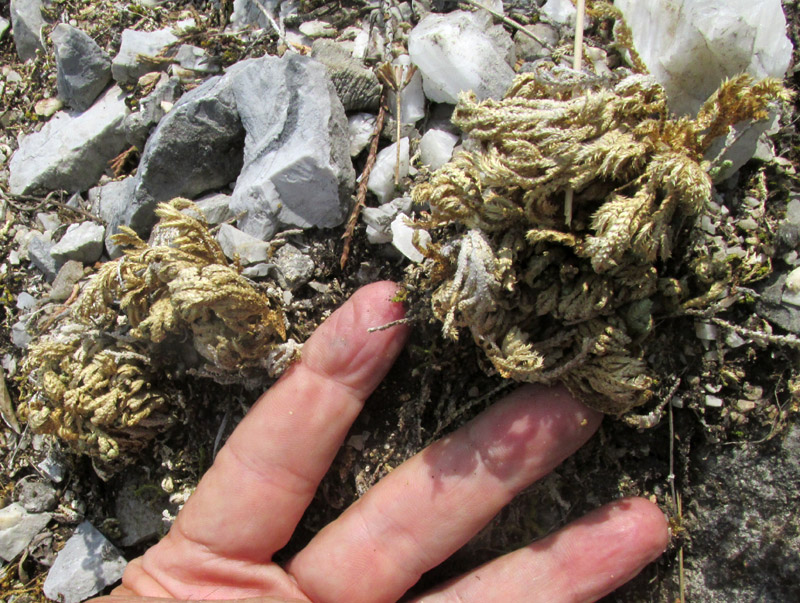
The above plants were so dried-out that their branches were gathered into balls to present less surface area to water evaporation and extreme sunlight. It was at the end of an exceptionally long, rainless dry season, and parts of the balls were white, looking dead; maybe the whole plants were dead. However, we've met a different species of this type of plant, often known as Resurrection Moss, because during dry periods it balls up similarly to the above, then with rain "resurrects." In the picture below, at least at a branch tip at the left-center, there's a little greenness, so maybe later these plants will indeed resurrect.
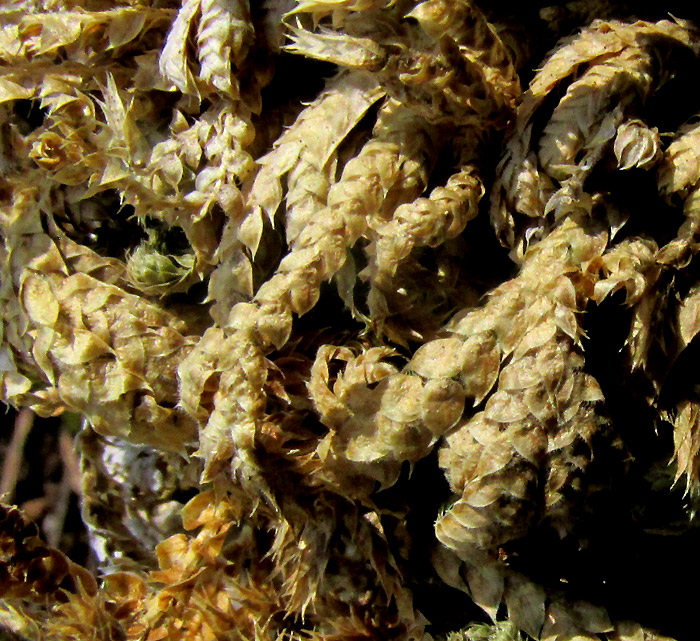
As with the above-mentioned Resurrection Moss, our plant isn't a moss, but rather its own special kind of spore-producing plant often known as spikemosses. They're members of the genus Selaginella, which is the only genus in the Spikemoss Family, the Selaginellaceae, which comprises about 700 Selaginella species. Above, close up, it's seen that spikemosses produce scale-like leaves. The main technical distinction between spikemosses and other kinds of spore-producing plants is that in the axils of their leaves they produce two sizes of spores, large female "megaspores," and small male "micospores." However, in the field these matters are hard to see. You just have to know what spikemosses generally look like.
The ~700 Selaginella species occur worldwide, mostly in the tropics, though in colder regions, too. In Mexico 80 species have been documented, and in our upland region of central Mexico known as the Bajío, there are 21. Fortunately for us, the Flora del Bajío treatment of Selaginella was published in 2021, so we can identify our spikemosses.

In our area, if you have a Selaginella with its leaves arranged in 4 ranks, not spiraling, and the plant is bushy to flat, not with slender stems crawling across its substrate and, at least with well watered green plants, the leaves are white-margined, you have SELAGINELLA PALLESCENS.
To firm up the identification you can note that leaves on the above close-up are sharp-pointed but the points are not extended into needlelike bristles, and along leaf margins, especially nearer the stem connections, tiny teeth are barely visible. In the above photo this is best seen on leaves at the lower, left corner.
Selaginella pallescens is native in uplands from northern Mexico south into South America, plus it's noted irregularly in other parts of the world, possibly because sometimes it's sold in pots as a "resurrection plant," and it escapes. Its commercial value also explains why it has an English name, Pale Spikemoss. In Spanish sometimes it's called doradilla.
The other "resurrection plant" linked to above, Selaginella lepidophylly, is famous as a traditional medicine, but this one is less so. Still, the 2017 study by Beatriz Rendón-Aguilar and others entitled "Ethnobotany of Lycophyta and Polypodiophyta in Priority Terrestrial Regions of Oaxaca, Mexico" reports that in Oaxaca one name for our Selaginella pallescens is planta del niñón, or "kidney plant." Often in traditional medicine any plant growing on rock and appearing to break down the rock is regarded as likely to demolish kidney stones.
The Flora of North America tells us that the taxonomy of the Spikemoss Family is controversial and not well understood. Consensus seems to be that the genus Selaginella should be broken into several genera, but so far nobody has published data showing why that needs to be done, so people are just waiting for the new genera to be established. Any day we may awaken to find that our plant is known as something like Stachygynandrum pallescens; for Stachygynandrum has been proposed as a name for the subgenus to which our plant appears to belong.
Entry from field notes dated September 2, 2023, taken in Los Mármoles National Park in the Eastern Sierra Madre mountains, Hidalgo state, MÉXICO; near ridgetop along road leading to Puerto de Piedra, which branches off the road between Trancas {on maps designated "Morelos (Trancas)"} and Nicolás Flores; limestone bedrock; elevation ~2,550m (~8,400ft); ~N20.81°, ~W99.23°
PALE SPIKEMOSS IN MOIST HABITAT

Pale Spikemoss thrives in both somewhat dry and somewhat moist environments, and its appearance can change from place to place. At first I didn't believe the above was the same species as documented in the earlier drier environment. However, the 2021 work by José Luis Villaseñor and others entitled "Riqueza y distribución de la flora vascular del estado de Hidalgo, México" reports that here in upland central Mexico's Hidalgo state 20 Selaginella species have been documented, and after disqualifying 19 of those species, what's left is Selaginella pallescens.
In the above picture, the spikemoss is pale, yellowish green, while the darker green, more slender plants are mosses. The spikemosses in the earlier, drier environment more clearly grew like bushes with branches spreading from a central root; they were "cespitose." Above, we must be seeing several individual spikemosses, or maybe branch tips of one large plant with the lower parts of its branches hidden within the mosses.

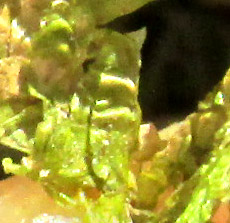
The above picture shows the species' vigorous branching. At the right, the center is occupied by a lateral leaf with its tip directed upward. At the leaf's base, on each side of the leaf's point of attachment with the stem, there's a downward-directed lobe, or auricle; that feature helps with the identification.
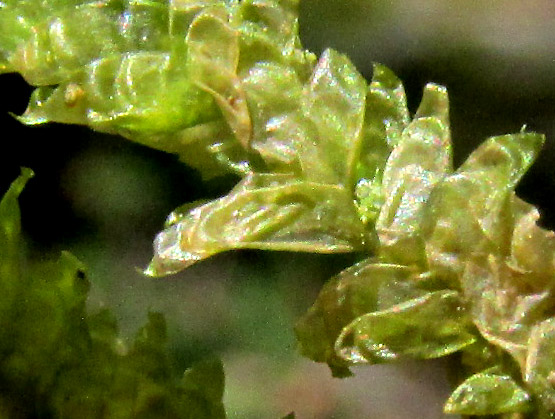
On the above picture's left side, the tips of two lateral leaves narrow to a needlelike, or aristate, point, and that's another good field mark, along with the leaves' general shapes. Two leaf forms occur in this species. The two featured larger leaves with aristate tips are one kind, while shorter median leaves with rounded to blunt tips arise between the lateral leaves. Some of the above leaves have lost their chlorophyll, probably because we're currently experiencing a severe drought.
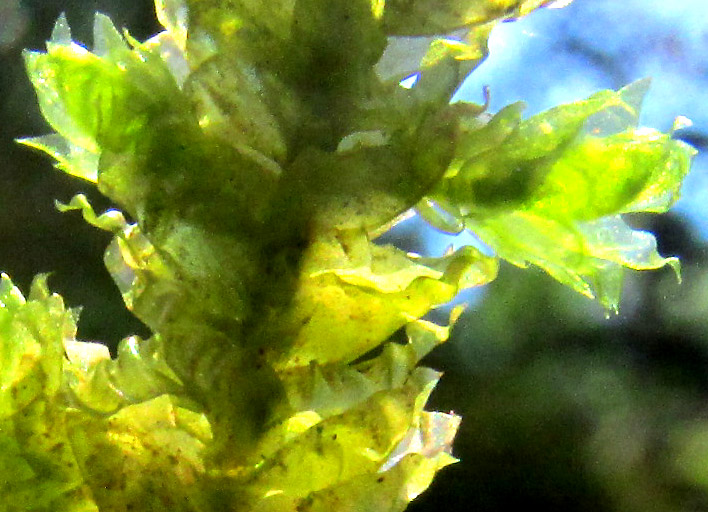
Above, leaves are starting to dry and curl. Most lateral leaves are sharply pointed but only a few on our plant were as clearly needle-pointed as in the previous picture.
Entry dated November 7, 2023, from notes taken at Cascadas de La Piedad waterfall 3kms NW of the community of San Pablo, municipality of Almeaco de Bonfil; bedrock of thick layers of compacted volcanic ash, or tuff; N20.1024°, W100.0019°, elevation 2360 meters (7750ft); extreme southern Querétaro state, MÉXICO
PALE SPIKEMOSS, ROSETTE VERSION

On a vertical, usually shaded face of a steeply inclined erosional gully surrounded by mountainside oak forest, the above Pale Spikemoss was less bushy and more like the flat rosette form seen in the more famous Resurrection Plant, Selaginella lepidophylla, also commonly found in this region.

Above, the leaves' white margins and teeth are more easily visible than in previous pictures.